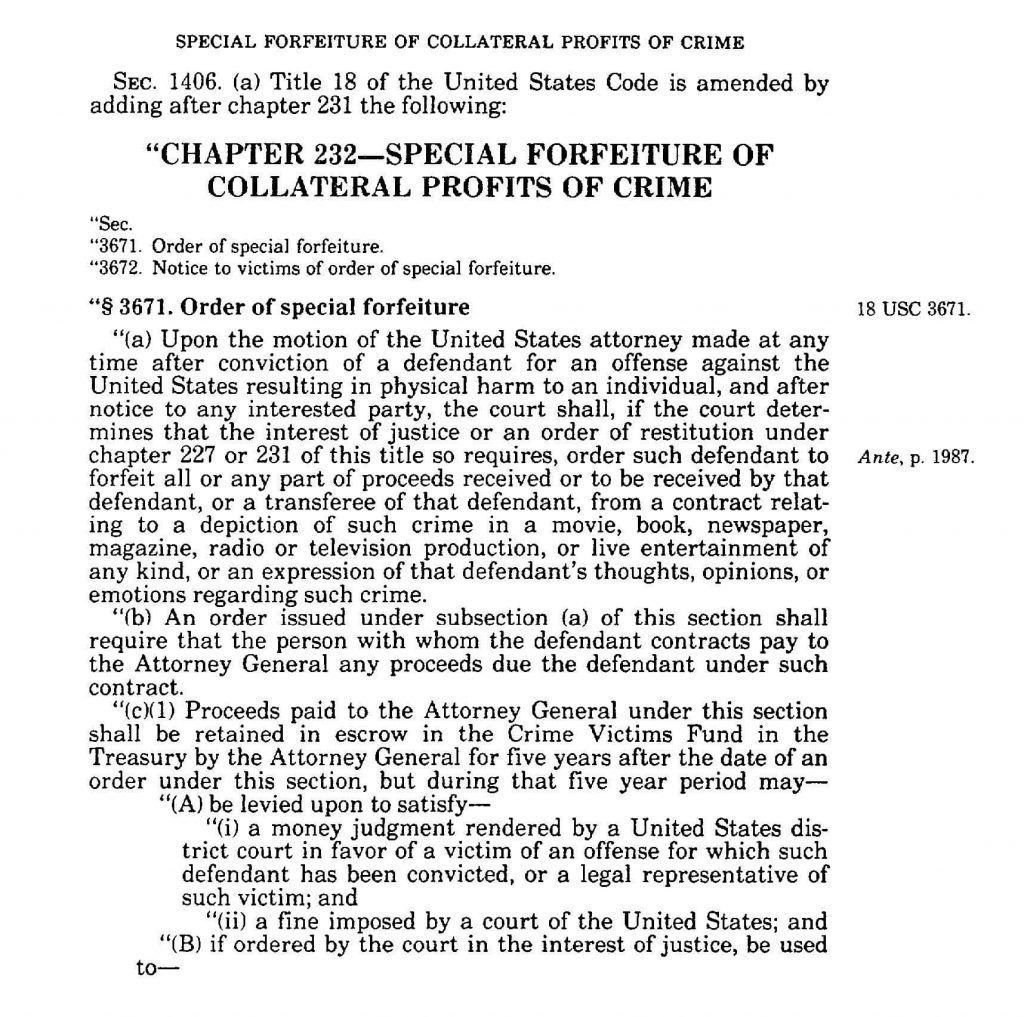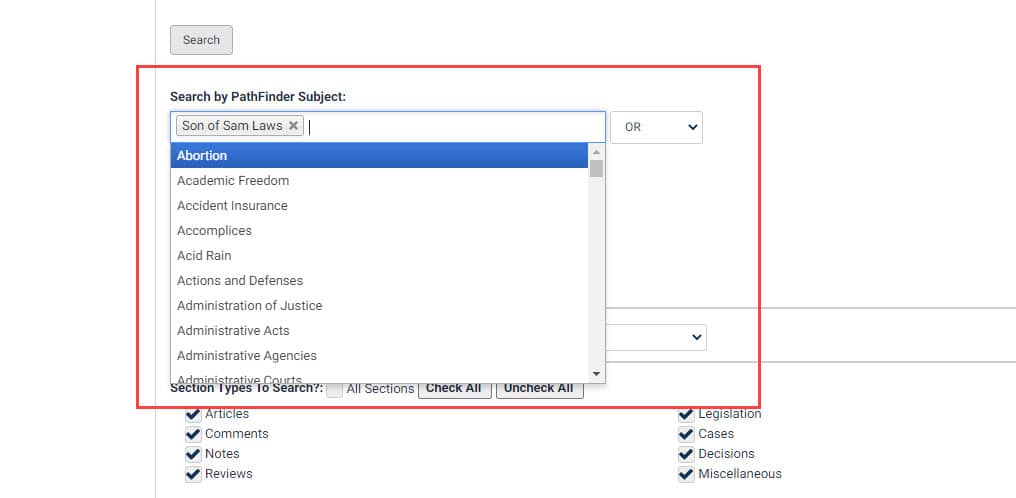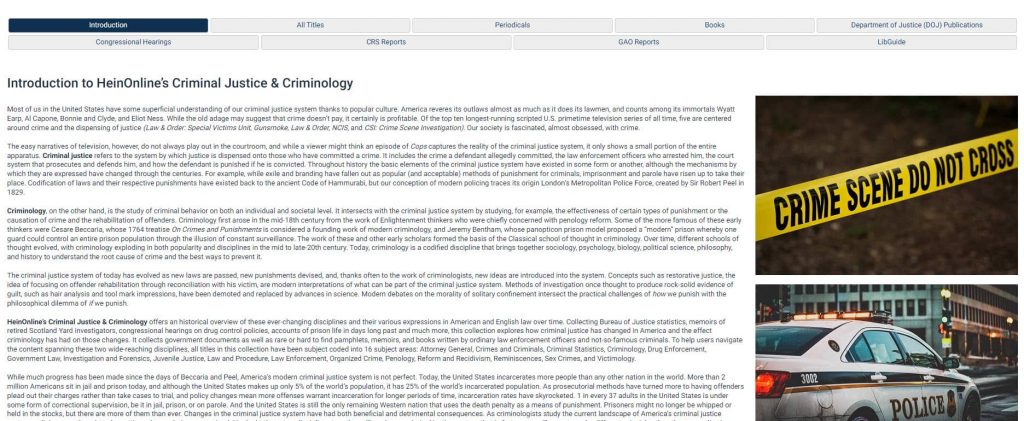True crime, for some, does indeed pay. Whether it is the NBC juggernaut Dateline, the latest season of Dirty John, or one of the dozens of true crime podcasts at the top of the charts, our society has a morbidly voracious fascination with killers, con men, and all their horrible deeds. It is not a new phenomenon. We may naturally think of the long-running television show Cops or the eerie chills of Unsolved Mysteries, but these television shows share a common spirit with the pulpy exploits sensationalized in 19th century penny dreadfuls and the broadsides sold at public executions, detailing the condemned’s crimes. The Newgate Calendar, cataloguing the crimes, trials, and executions of history’s criminals, was published in various editions throughout the 18th and 19th centuries and was one of the most popular published works in Great Britain; users can find many permutations of this classic, including one from 1773, in HeinOnline.

Whatever the dominant media form of the day, true crime has been a perennial subject, devoured by consumers. But thanks partly to victims’ rights movements, moral quandaries over the implications of profiting off victims’ suffering or glorifying perpetrators’ cruelty through incessant retellings of their crimes have dogged the true crime genre. Some criminals have even attempted to profit off their own crimes, cognizant of the public’s appetite for criminal tales. Using HeinOnline, let’s explore one of the most well-known legal attempts to curb criminals’ ability to profit from their own notoriety: Son of Sam laws.
A Monster on the Loose
From July 1976 until July 1977, New York City was under siege. Someone was targeting young women at random, shooting them with a .44 Bulldog revolver. The killer targeted women with long dark hair and couples sitting in parked cars,[1]George Hodak, Son of Sam Is Arrested, 93 A.B.A. J. 72 (2007). This article can be found in HeinOnline’s Law Journal Library. claiming victims in Queens, the Bronx, and Brooklyn. He seemed to strike at random, shooting complete strangers. Christened the “.44 caliber Killer” by the press, the killer received a new moniker in April 1977 when a handwritten letter was left near the bodies of his latest victims, addressed to then-NYPD Captain Joseph Borrelli. “I am deeply hurt by your calling me a woman hater,” the letter began. “I am not. But I am a monster. I am the Son of Sam.”
Over the course of his spree, the Son of Sam killed six people, wounding nine. In May 1977, a second letter was sent to the New York Daily News. It was cryptic, boasting, ridiculing police efforts to apprehend him, reminiscent of the missives sent by the Zodiac Killer to the San Francisco Chronicle the previous decade, and the contemporaneous tauntings of the Yorkshire Ripper in England. The Son of Sam’s killing spree finally came to an end on August 10, 1977, when 24-year-old Yonkers native David Berkowitz was arrested with a .44 caliber Bulldog revolver in the backseat of his car. Berkowitz quickly confessed to being the infamous Son of Sam, the target of the largest manhunt in NYPD history,[2]George Hodak, Son of Sam Is Arrested, 93 A.B.A. J. 72 (2007). This article can be found in HeinOnline’s Law Journal Library. claiming that he had been ordered to kill by a possessed black Labrador Retriever owned by his former neighbor Sam Carr. Against the advice of his lawyers, Berkowitz pled guilty. In 1978, he was sentenced to six 25-years-to-life sentences and is currently imprisoned in Shawangunk Correctional Facility.
Berkowitz’s crimes, arrest, and conviction created a media frenzy—attention that Berkowitz seemed to enjoy.[3]Simon & (and) Schuster v. N.Y. Crime Victims Board, 4 MD. J. CONTEMP. LEGAL Issues 309 (1993). This article can be found in HeinOnline’s Law Journal Library. Even prior to Berkowitz’s arrest, rumors swirled about the high sum the killer could earn if he sold his story, with sums tossed out up to $200,000[4]Melissa J. Malecki, Son of Sam: Has North Carolina Remedied the Past Problems of Criminal Anti-Profit Legislation, 89 MARQ. L. REV. 673 (2006). This article can be found in HeinOnline’s Law Journal Library. for an exclusive account of the killings straight from the perpetrator’s pen. After his arrest, Berkowitz received $75,000[5]Karen M. Ecker & Margot J. O’Brien, Simon & Schuster, Inc. v. Fischetti: Can New York’s Son of Sam Law Survive First Amendment Challenge , 66 NOTRE DAME L. REV. 1075 (1990). This … Continue reading from the publisher McGraw-Hill for the rights to his story.
Crime Doesn’t Pay in New York
Outraged over the possibility of this cowardly killer getting rich off his crimes, New York State Senator Emanuel Gold introduced “An Act to amend the executive law, in relation to requiring moneys received by criminals as a result of the commission of crime to be paid to the crime victims’ compensation board for distribution to the victims of such crimes.”[6]1977 N.Y. Laws § 632-a. This law can be found in HeinOnline’s Session Laws Library. Known popularly as the “Son of Sam Law,” NY Exec. Law § 632-a required any entity—such as book publishers, movie producers, play writers, and so on—who contracted with a convicted criminal for the purpose of detailing his crime to hand over any profits made from their creative venture. The State, in turn, would place those monies in escrow for five years and would use them to pay judgments awarded to victims who brought civil suits against the convicted.

In the wake of New York’s lead, some 40 other states[7]Lori F. Zavack, Can States Enact Constitutional Son of Sam Laws after Simon & (and) Schuster, Inc. v. New York State Crime Victims Board, 37 St. Louis U. L.J. 701 (1993). This article can be found in HeinOnline’s … Continue reading enacted their own version of Son of Sam laws to prevent criminals from profiting from their misdeeds. In 1984, Congress passed the Victims of Crime Act (VOCA).[8]98 Stat. 1837 (1984). This statute can be found in HeinOnline’s U.S. Statutes at Large. Among other things, VOCA established the Crime Victims Fund, from which monies could be paid out to victims of federal crimes to help them pay medical bills, recoup lost wages, and pay other crime-related expenses. It was funded by various revenue streams, from criminal fines and fees to forfeited bail bonds. Like the New York Son of Sam law, VOCA also prohibited persons convicted of federal crimes from profiting off their victims; any convicted criminal who sold their story would forfeit their profits, which were placed in the Crime Victims Fund.

A Wiseguy Walks into the Supreme Court
In 1991, the Supreme Court of the United States unanimously declared New York’s Son of Sam law unconstitutional. The case, Simon & Schuster, Inc. v. Members of the New York State Crime Victims Board, centered on well-known mobster Henry Hill’s 1985 autobiography Wiseguy, which was eventually adapted into the 1990 Martin Scorsese film Goodfellas. Soon after the book’s publication,[9]502 U.S. 105 (1991). This case can be found in HeinOnline’s U.S. Supreme Court Library. the New York Crime Victims board ordered its publisher, Simon & Schuster, to pay into the state’s Son of Sam escrow fund,[10]Melissa J. Malecki, Son of Sam: Has North Carolina Remedied the Past Problems of Criminal Anti-Profit Legislation, 89 MARQ. L. REV. 673 (2006). This article can be found in HeinOnline’s Law Journal Library. claiming it was owed both money already paid to Hill for his book and any future payments under the law. Simon & Schuster sued the Crime Board, arguing that the Son of Sam law violated the First Amendment.
The United States Supreme Court sided with Simon & Schuster, finding the New York law “significantly overinclusive.”[11]502 U.S. 105 (1991). This case can be found in HeinOnline’s U.S. Supreme Court Library. Because the law “plainly imposes a financial disincentive only on speech of a particular content,”[12]502 U.S. 105 (1991). This case can be found in HeinOnline’s U.S. Supreme Court Library. it violated Hill and other potential similar authors’ First Amendment right.
In response to the Supreme Court’s ruling, New York State revised[13]Arlen Pyenson, Criminal Manifestos and the Media: Revisiting Son of Sam Laws in Response to the Media’s Branding of the Virginia Tech Massacre, 26 CARDOZO Arts & ENT. L.J. 509 (2008). This article can be found … Continue reading its Son of Sam law to instead target profits earned in the commission of a crime, rather than the criminal’s speech about his crime. The revision also exempted past crimes for which a criminal was not convicted, a revision that had to be directly inspired by Hill; Hill, while having been convicted of and served time for extortion, ultimately became an informant for the FBI in 1980 in exchange for immunity against more serious charges related to his illicit lifestyle.
Ironically, the original Son of Sam law never applied[14]502 U.S. 105 (1991). This case can be found in HeinOnline’s U.S. Supreme Court Library. to the original Son of Sam, David Berkowitz. Berkowitz, who claimed to be part of a Satanic cult and acting on the orders of a talking, demonic dog, was declared unfit to stand trial. While he pled guilty to the shootings, he was never convicted by a jury.
Today, Son of Sam laws remain in effect in many states, including New York. To see how we found some of the resources used to write this blog post, start with a simple search in HeinOnline’s Law Journal Library: “son of sam law” OR “son of sam laws”
Using proper search syntax—in this case, applying quotation marks around our key phrase—takes a “simple” search and elevates it into a targeted hunt.

Results include:
- Kathleen Howe, Is Free Speech Too High a Price to Pay for Crime – Overcoming the Constitutional Inconsistencies in Son of Sam Laws , 24 LOY. L.A. ENT. L. REV. 341 (2004).
- Suna Chang, The Prodigal Son Returns: An Assessment of Current Son of Sam Laws and the Reality of the Online Murderabilia Marketplace, 31 Rutgers COMPUTER & TECH. L.J. 430 (2005).
- Karen M. Ecker & Margot J. O’Brien, Simon & Schuster, Inc. v. Fischetti: Can New York’s Son of Sam Law Survive First Amendment Challenge, 66 NOTRE DAME L. REV. 1075 (1990).
- Rebekah Binger, Prison Ain’t Hell: An Interview with the Son of Sam – David Berkowitz, and Why State-Funded Faith-Based Prison Rehabilitation Programs Do Not Violate the Establishment Clause, 31 PACE L. REV. 488 (2011).
Don’t like doing all that typing? PathFinder has you covered with a dedicated Son of Sam Laws topic:

HeinOnline’s Criminal Justice & Criminology Database
Broadly, Son of Sam laws touch on issues of victims’ rights and the broader discipline of victimology in criminology. Victimology focuses on the relationship between victim and offender, including the psychological effects of crime on a victim, and the victim’s interactions with the criminal justice system. HeinOnline’s Criminal Justice and Criminology collection contains thousands of titles related to crimes, criminals, and the criminal justice system. Each title in this collection has been analyzed by HeinOnline editors and assigned one or more subjects to help users target their research. Explore victims’ rights with our Victimology subject, which contains titles such as:
- The Crime Victims Fund: Federal Support for Victims of Crime (2020)
- Crime Victims’ Rights Act: A Summary and Legal Analysis of 18 U.S.C. Sec. 3771 (2021)
- New Directions from the Field: Victim’s Rights and Services for the 21st Century (1998)
- Victims of Crime Compensation: Hearings before the Subcommittee on Criminal Justice of the Committee on the Judiciary, House of Representatives, Ninety-Fifth Congress, First Session on, H.R.7010 and Related Bills, Victims of Crime Compensation Legislation (1977)

It would be a crime to miss out on future posts from the HeinOnline Blog. Don’t be guilty of missing new posts by becoming a subscriber today.
HeinOnline Sources[+]
| ↑1, ↑2 | George Hodak, Son of Sam Is Arrested, 93 A.B.A. J. 72 (2007). This article can be found in HeinOnline’s Law Journal Library. |
|---|---|
| ↑3 | Simon & (and) Schuster v. N.Y. Crime Victims Board, 4 MD. J. CONTEMP. LEGAL Issues 309 (1993). This article can be found in HeinOnline’s Law Journal Library. |
| ↑4, ↑10 | Melissa J. Malecki, Son of Sam: Has North Carolina Remedied the Past Problems of Criminal Anti-Profit Legislation, 89 MARQ. L. REV. 673 (2006). This article can be found in HeinOnline’s Law Journal Library. |
| ↑5 | Karen M. Ecker & Margot J. O’Brien, Simon & Schuster, Inc. v. Fischetti: Can New York’s Son of Sam Law Survive First Amendment Challenge , 66 NOTRE DAME L. REV. 1075 (1990). This article can be found in HeinOnline’s Law Journal Library. |
| ↑6 | 1977 N.Y. Laws § 632-a. This law can be found in HeinOnline’s Session Laws Library. |
| ↑7 | Lori F. Zavack, Can States Enact Constitutional Son of Sam Laws after Simon & (and) Schuster, Inc. v. New York State Crime Victims Board, 37 St. Louis U. L.J. 701 (1993). This article can be found in HeinOnline’s Law Journal Library. |
| ↑8 | 98 Stat. 1837 (1984). This statute can be found in HeinOnline’s U.S. Statutes at Large. |
| ↑9, ↑11, ↑12, ↑14 | 502 U.S. 105 (1991). This case can be found in HeinOnline’s U.S. Supreme Court Library. |
| ↑13 | Arlen Pyenson, Criminal Manifestos and the Media: Revisiting Son of Sam Laws in Response to the Media’s Branding of the Virginia Tech Massacre, 26 CARDOZO Arts & ENT. L.J. 509 (2008). This article can be found in HeinOnline’s Law Journal Library. |



